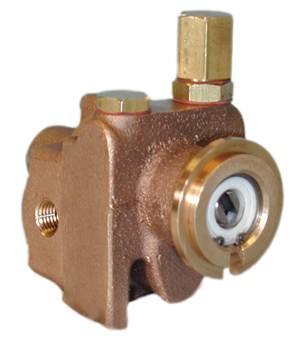PT FTS Indonesia
The carbonator motor mounting uses a circular clamp, similar to a hose clamp, as means of attaching the pump to a specially machined hub on the motor. This concept was first developed for the vending machine industry to pump carbonated beverages in soft drink dispensers. The main advantages are compactness and economy due to the elimination of the adapter casting. Carbonator motors are readily available from electric motor distributors.
Gear Pumps N91
FEATURES
- Bronze Body, Stainless Steel Shaft
- Nitrile Mechanical Seal (fluoroelastomer optional)
- Self-lubricating Carbon Bearings
- Carbonator Motor Mount
- Bronze Spur Gears
- 200 PSI capability
- Superior to Vane Pumps
LIQUIDS & TEMPERATURES
Bronze pumps are suitable for water, oil, and mild chemicals in the pH-range from 4-10. Viscous liquids may be handled with carbonator pumps up to a viscosity of 300 SSU. Higher viscosities require a pump speed lower than 1725 RPM, which is currently not available in carbonator motors. Liquids containing abrasives, solids, powders or pigments are highly detrimental to pump life and must be avoided. The recommended liquid temperature range is from 32o F to 140oF. If more extreme temperature conditions exist, factory should be consulted. Allowing the liquid to freeze in the pump can cause damage.
SUCTION LIFT
For a first start-up, the pump should be primed to avoid dry running. Gear pumps are self-priming, but a foot valve with strainer is recommended at the beginning of the suction line. This will keep the gear chamber primed to insure instant flow when the pump is started. Maximum suction lift is 20 feet. The suction line should be as short as possible.
ROTATION AND RELIEF VALVE
The relief valve is not intended to be a metering or flow control device. Its main purpose is to function as a discharge pressure relief when the discharge pressure exceeds the spring tension. Overheating can occur within 5-10 minutes if the discharge line is completely shut off for extended periods.
Unless otherwise specified, the pump motor unit is supplied by the factory for shaft rotation clockwise from shaft end. Reversing the motor rotation will reverse the “in” and “out” ports and also requires changing the relief valve location. The relief valve is always on the discharge side in this pump series. The factory pressure setting is 50 PSIG. To increase pressure, turn the relief valve adjusting screw in a clockwise direction. For relief settings between 100-200 PSI, specify high-pressure spring (N91D)
To reverse single-phase motors, find instructions on the inside of the junction box cover or on the nameplate of the motor.
Order Enquiry Form
Contact form description text




